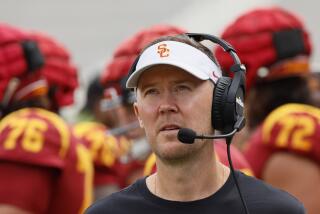50 Years Later, Jordan Is Still a Major Breakaway Threat
- Share via
SAN DIEGO — USC halfbacks have always fit into a certain mold, one in which speed seems to be cast more than any other trait.
The Trojans have done well with that die, turning out one back after the other who made long breakaway runs a mainstay in their offensive diet.
But imagine the quintessential USC halfback, one with world-class speed, calling himself “just cannon-fodder.”
A halfback who could outrun anyone in the country, or the world for that matter, saying of his role, “Well, I was used for all kinds of things in practice.”
In the late 1930s, Payton Jordan was the quintessential USC halfback who wasn’t.
“I was just a team member,” Payton said. “I would never say I was a star.”
If not on the football field, he most definitely was so on the track.
In 1938, he and three other USC sprinters ran a world-record 40.2 seconds in the 440-yard relay.
It stood for 20 years.
In 1941, Jordan turned in another world record when he clocked a 9.5 in the 100 yards on grass.
That stood for 27 years.
Notice that the marks were sandwiched around 1940, normally an Olympic year. The reason is that World War II intervened and kept Jordan away from possible gold.
Some 49 years later, that missed opportunity doesn’t seem to bother Jordan, 72. Jordan is still competing, but more important, he’s still having fun. That, he says, is what track and field is all about.
“I’ve always enjoyed competing,” Jordan said. “The people in the sport are what make it worthwhile.”
On Friday and Saturday, Jordan competed in the TAC/USA National Masters Championship 100 and 200 meters in the 70-74 age group. He broke the tape in each comfortably ahead of the next finisher.
Although his 13.4 in the 100 and 28.2 in the 200 were not world-record age-group times, they were nevertheless faster than any other 70-74-year-old has run. Jordan owns both marks, 13.0 in the 100 and 26.8 in the 200, set last year.
Jordan says he is out to better himself at next week’s World Games in Eugene, Ore.
“I ran a good 100 and 220,” Jordan said. “But I didn’t run up to my standard. I came in here with the idea of getting the world records if I could. . . . Still, I think I’m all right. I feel I’m on schedule and on plan and with three days rest (before running in Eugene), I think I can do it.”
Jordan always has in the past.
Although he missed out on a possible trip to Japan in 1940, he did manage to tag along with the Olympic team to the 1964 Games in Tokyo and again in 1968 to Mexico City.
In Tokyo, he was an assistant track coach, and in Mexico City, he was the head coach. As such, Jordan faced perhaps the most difficult task ever presented to one in his position--he had to mend a gash between the white and black team members caused by a threatened boycott by the black athletes.
That Jordan did his job was made evident by 24 medals--12 gold.
“We just sat down and talked about how hard everyone worked for so long to get ready for this lifetime opportunity,” Jordan said about how brought the team together. “And they felt that way, too.
“It wasn’t really something too important that we didn’t expect. It was like the high altitude in Mexico City--something we weren’t used to--or like an injury. It was just something we had to work through and overcome.”
After 40 years of coaching, including 25 at Stanford, Jordan tired of teaching and yearned to begin competing again. So in 1972, he laced up his running shoes. He picked up right where he left off.
At age 55, he set the age-group world record in the 100 at 11.6. He’s still managing runs under 13 seconds.
“It’s no different than when I was a kid,” Jordan said. “The values, the experiences, they all stay the same.”
More to Read
Fight on! Are you a true Trojans fan?
Get our Times of Troy newsletter for USC insights, news and much more.
You may occasionally receive promotional content from the Los Angeles Times.






